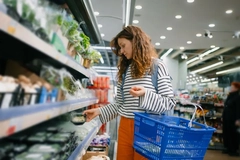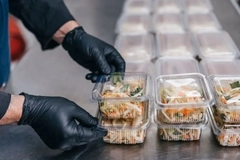Coffee pack trends: Connected tech, compostability and capsule designs pegged as the year’s main challenges
10 Jan 2024 --- Demand for recyclable monomaterial options is increasing as regulations on packaging become more stringent, and a rise in out-of-home consumption is following the relaxation of COVID-19 pandemic regulations, according to Katri Saarenheimo, interim head of Global Communications at Huhtamaki.
Saarenheimo says the company is observing increasing demand for packaging options that are recyclable and home compostable, and interest in smarter materials. “We equally welcome the increasing interest seen to innovate solutions across the value chain for better collection and recycling infrastructure for packaging.”
“Many of our customers across FMCG, retail and QSR have set specific targets on these topics, and more sustainable packaging solutions play an essential role in achieving those targets,” Saarenheimo tells Packaging Insights.
Tipa’s CEO and co-founder, Daphna Nissenbaum, tells us that consumers are increasingly conscious of environmental issues, leading to a demand for sustainable and eco-friendly packaging solutions. Biodegradable materials, compostable packaging and recyclable options are likely to be in high demand.
“At Tipa, we have been developing our compostable coffee packaging materials to ensure the coffee remains as aromatic and flavorful as the day it was roasted while reducing the environmental impact of the product’s packaging,” says Nissenbaum.
Huhtamaki sees an acceleration in the need and demand for environmentally sustainable coffee packaging (Image credit: Huhtamaki). Legislative challenges ahead
Huhtamaki provides sustainable and innovative packaging solutions for the coffee and tea industry. The company’s portfolio includes a range of flexible packaging, cups, lids and coffee pods for on-the-shelf and on-the-go applications. Huhtamaki also offers paper- and fiber-based materials, from cups and lids used in coffee shops and restaurants to home compostable coffee capsules.
Even though consumer demand for more sustainable packaging has been developing for longer, Saarenheimo says Huhtamaki sees an acceleration in the need and demand for such solutions in recent years. “This is also linked to legislation changes and policy debates in many markets globally.”
The company expects the main trends to be linked to legislative regulations on single-use plastics and customer pledges to reduce the environmental impact of plastic packaging.
“We have a comprehensive range of products designed to support the transition from non-recyclable to recyclable packaging materials, as well as fully paper-based solutions for coffee and tea at scale,” asserts Saarenheimo.
“Our recyclable flexible packaging solutions offer best-in-class barrier and plug & play performance on the customer packaging lines. In our on-the-go packaging solutions, we focus on sustainable, renewable materials in the packaging and scaling up new collection streams to ensure that these circular materials get reused according to their potential.”
Making consumers part of the journey
Nissenbaum says consumers are increasingly interested in knowing the journey of their products. “Packaging that communicates transparency and offers traceability, showcasing the coffee’s origin and production process, may also gain traction.”
“The integration of technology into packaging, such as smart labels or QR codes providing information about the coffee’s origin, brewing instructions or interactive content, could become more prevalent,” says Nissenbaum.Nissenbaum warns that coffee capsules are often not fully compostable unlike stated on their packaging (Image credit: Tipa).
To tap into these trends, Tipa furthers its collaborations with innovators such as ATI to offer the most sustainable product to its customers. The newly launched coffee pod lid allows brands to personalize the whole pod, allowing brands to communicate their sustainability messaging directly on the pod itself.
“Currently, Tipa’s packaging range includes compostable coffee lids, pillow bag packaging, side gusset pouches and sachet packaging, all designed for optimal freshness. Whether for a single-serve or a full bag of beans, our products cater to all coffee packaging needs with a commitment to leaving no trace,” asserts Nissenbaum.
“To ensure a minimal carbon footprint of our packaging, Tipa’s packaging technology is designed to fit existing machinery and supply chains in a ‘plug and play solution.’ This means our packaging is developed close to our customers, reducing transportation costs and ensuring minimal supply chain disruption.”
The compostability debate
Compostable claims have faced criticism recently, leaving consumers confused about how to dispose of their packaging. Furthermore, industry experts often find that packaging is not compostable unless the right conditions are provided.
Nissenbaum says Tipa designed its compostable packaging as the “ultimate solution” to the plastic packaging crisis. “We therefore take the safe disposal of our products incredibly seriously.”
Nissenbaum says Tipa’s compostable packaging is the “ultimate solution” to the plastic packaging crisis (Image credit: Tipa).“Tipa’s products all abide by the highest levels of certifications and can be disposed of in either a home composter as certified by TÜV Austria, TÜV OK Compost Home and ABA, or an industrial composter. We ensure that our packaging contains clear instructions for disposal and work with the retailers we supply to ensure this message is communicated successfully with the end consumer.”
“Specifically, our recently expanded range of coffee capsules and lids reflects the latest research by Wageningen University and Research, which found that compostable, bio-based coffee capsules are the most environmentally sustainable option when considering material circularity and GHG emissions. Tipa’s new compostable coffee capsule lid packaging can be disposed of in both home and industrial composters, where it returns fully to the earth within only 21 days.”
Conventional material issues
Previously, applications for coffee packaging have been dominated by aluminum and plastic, both of which are detrimental to the environment, warns Nissenbaum. “Despite the messaging that aluminum is infinitely recyclable, insight offered by Mark Kelp, CEO of packaging developer ATI, found that the aluminum capsule is not 100% aluminum.”
“These capsules have a coating on both sides, a silicone ring on the flange, and a piece of plastic at the top of the capsule, making the product costly to sort and clean for recycling. This results in high amounts of the aluminum being unsuitable for reuse and, as such, ending up in landfill or incineration,” explains Nissenbaum.
“As we look out to 2024 with the opportunity to significantly reduce our plastic footprint, it is essential that plastic alternatives are thoroughly analyzed and scientifically approved.”
By Natalie Schwertheim












